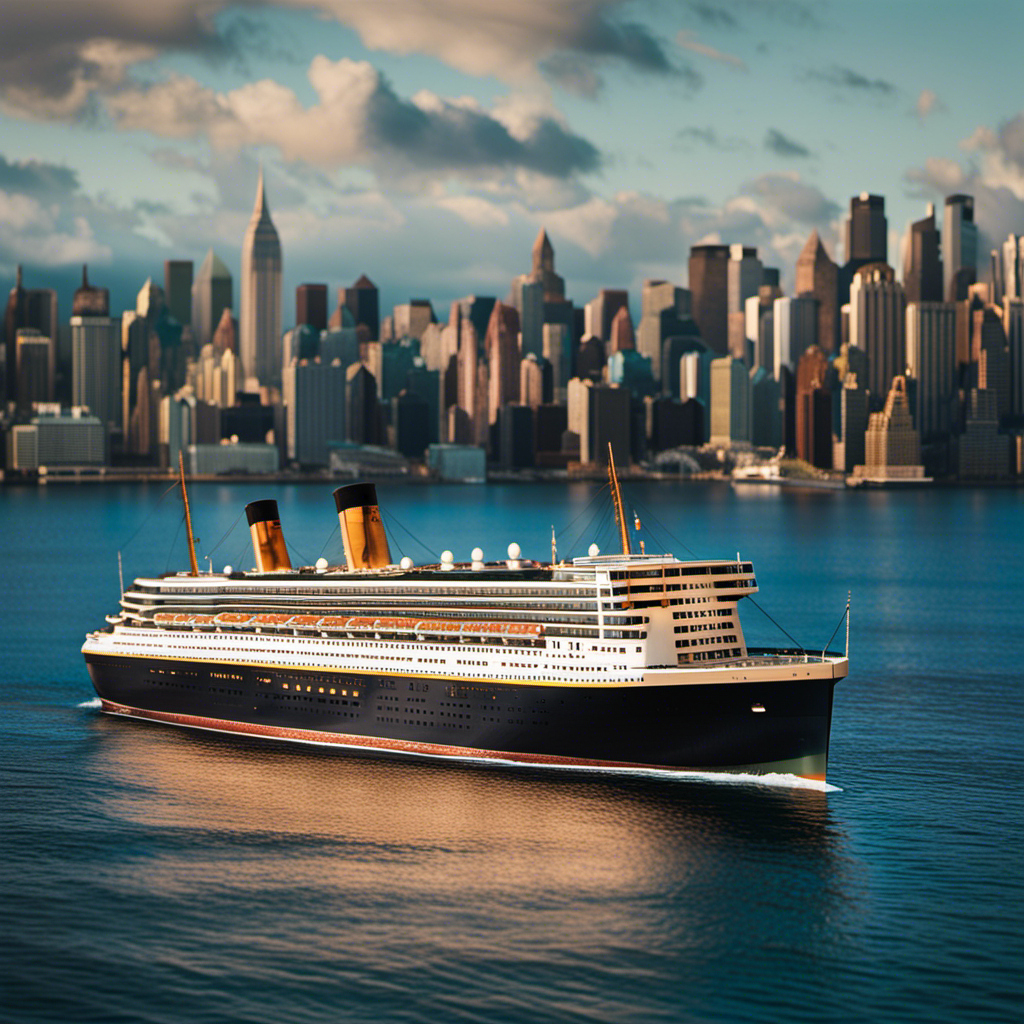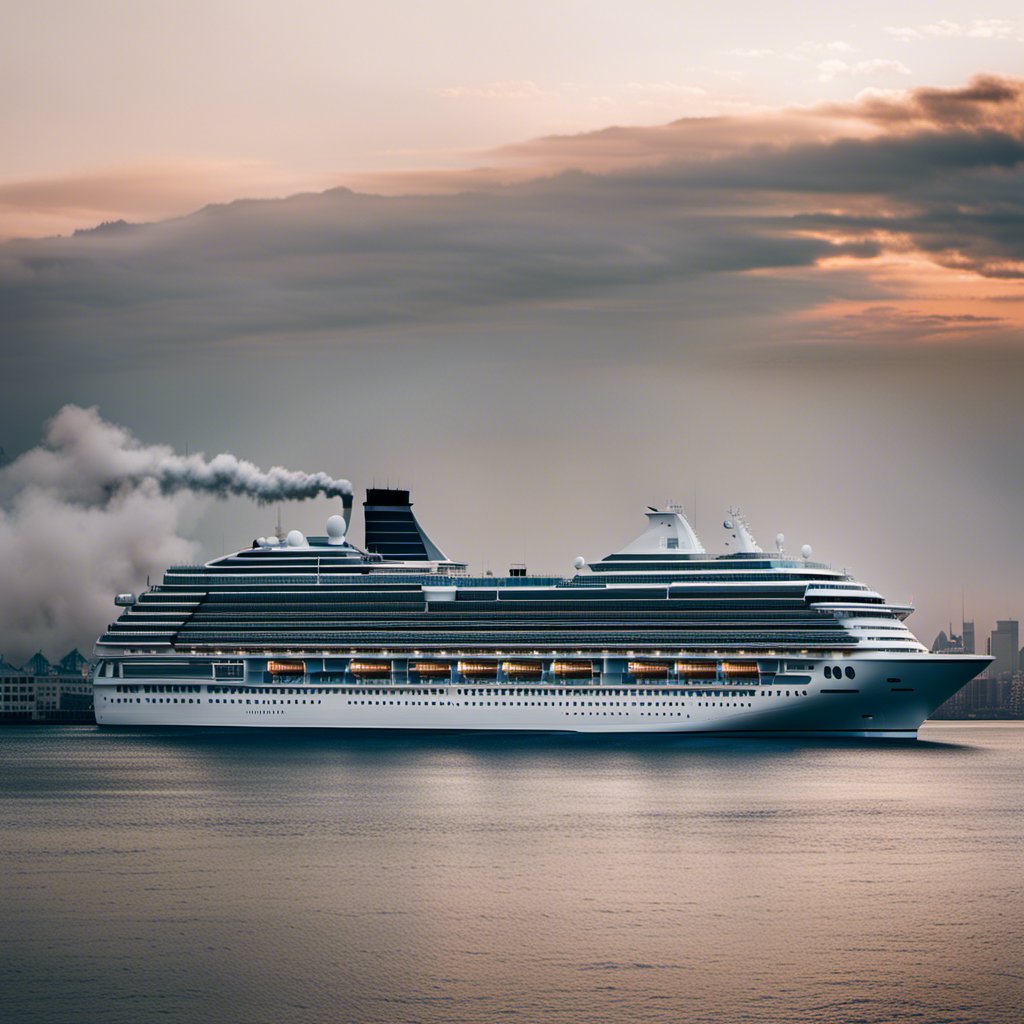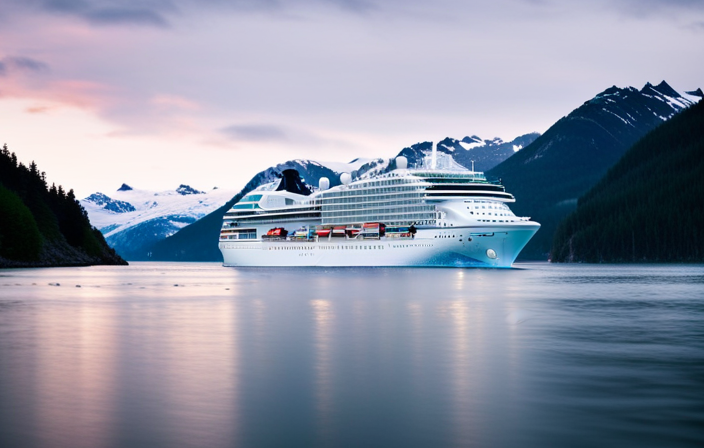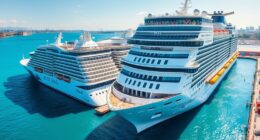The colossal dimensions and splendor of the Titanic have perpetually fascinated me. When I envision standing on its deck, I am intrigued to compare it with today’s cruise ships.
In this article, we will delve into the historical significance of the Titanic’s size, explore its dimensions, compare its passenger capacity to that of modern cruise ships, and examine the engineering marvels that differentiate the Titanic from its contemporary counterparts.
Join me as we embark on a journey to uncover just how big the Titanic truly was.
Key Takeaways
- The Titanic revolutionized the shipbuilding industry and set new standards for luxury and innovation.
- The Titanic’s size challenged the limits of engineering and had a lasting impact on the shipbuilding industry.
- Modern cruise ships have surpassed the Titanic in terms of passenger experience and environmental impact.
- The construction techniques and technological advancements in modern cruise ships have come a long way since the early 20th century.
Historical Significance of the Titanic’s Size
The Titanic’s size was unprecedented for its time and it remains a symbol of the grandeur and tragedy of the era. Its historical significance cannot be overstated, as it revolutionized the shipbuilding industry and set new standards for luxury and innovation.
The impact on the industry was immense, with shipbuilders around the world striving to replicate its size and opulence. The Titanic’s colossal dimensions challenged the limits of engineering and showcased the capabilities of early 20th century technology. Its construction required groundbreaking techniques and materials, pushing the boundaries of what was thought possible.
The immense size of the Titanic not only captivated the public’s imagination but also had a lasting impact on the shipbuilding industry, forever changing the way ships were designed and built.
Now, let’s dive into the dimensions of the Titanic: length, width, and height.
Dimensions of the Titanic: Length, Width, and Height
One notable fact about the Titanic is that its dimensions include a length of 882 feet, a width of 92 feet, and a height of 175 feet. These measurements were truly remarkable for a ship during the early 20th century.
To understand the historical context, it is important to consider the architectural design of the Titanic. It was built in the Edwardian era, a time when luxury and opulence were highly valued. The ship’s grandeur was evident in its elaborate interiors and extravagant features. The Titanic’s dimensions were carefully planned to accommodate the needs of its passengers, including luxurious cabins, dining rooms, and entertainment spaces. This attention to detail showcased the ship’s exceptional architectural design and contributed to its status as a symbol of luxury and sophistication.
Now, let’s compare the passenger capacity of the Titanic to that of modern cruise ships.
Comparing Passenger Capacity: Titanic Vs. Modern Cruise Ships
Let’s take a look at how the passenger capacity of the Titanic compares to that of modern cruise ships. When it comes to passenger experience, modern cruise ships offer a wide range of onboard activities. From water parks and casinos to Broadway-style shows and gourmet dining, there is something for everyone. In contrast, the Titanic, although luxurious for its time, had limited onboard activities by today’s standards.
Next, let’s consider the environmental impact. The Titanic was powered by coal, which produced significant emissions and contributed to air pollution. In contrast, modern cruise ships have adopted more sustainable technologies, such as using cleaner fuels and implementing advanced waste management systems, to minimize their environmental footprint.
Overall, modern cruise ships have far surpassed the Titanic in terms of passenger experience and environmental impact. Now, let’s delve into the engineering marvels and explore the construction differences between the Titanic and modern cruise ships.
Engineering Marvels: Construction Differences Between the Titanic and Cruise Ships
Take a moment to consider how cruise ships today are constructed differently from the Titanic.
The construction techniques and technological advancements in shipbuilding have come a long way since the early 20th century.
The Titanic was built using traditional riveting methods, where iron plates were joined together using hot rivets.
In contrast, modern cruise ships utilize advanced welding techniques, allowing for stronger and more seamless connections between steel plates.
Additionally, the use of computer-aided design and manufacturing has revolutionized the construction process, enabling precise measurements and improving overall efficiency.
These advancements not only enhance structural integrity but also contribute to the sleek and elegant design of modern cruise ships.
With these construction advancements, exploring the Titanic’s amenities and features will provide a fascinating glimpse into the past.
Exploring the Titanic’s Amenities and Features
Exploring the amenities and features of the Titanic reveals a luxurious and opulent experience for its passengers. The ship was designed with the utmost attention to detail, offering unprecedented levels of comfort and entertainment. The Titanic boasted amenities such as a grand staircase, a swimming pool, a gymnasium, and a Turkish bath.
The first-class accommodations were adorned with lavish furnishings and spacious cabins. The ship also featured a state-of-the-art dining room, where passengers could enjoy gourmet meals prepared by world-class chefs. In comparison to modern cruise ships, the amenities on the Titanic may seem outdated, but they were considered cutting-edge at the time.
Today, cruise ships offer an array of amenities such as water parks, casinos, theaters, and even ice skating rinks. These modern amenities showcase the evolution of the cruise ship industry, but the Titanic’s legacy as a symbol of luxury and grandeur still endures.
The Titanic’s Legacy: Impact on the Cruise Ship Industry
You might be surprised to learn that the Titanic’s legacy continues to shape the cruise industry today. The impact of this historic tragedy on tourism and safety regulations cannot be overstated. Here are three ways the Titanic’s legacy has influenced the cruise ship industry:
-
Enhanced Safety Measures: The sinking of the Titanic highlighted the need for improved safety regulations in the maritime industry. Today, cruise ships are equipped with advanced safety features such as lifeboats, life jackets, and modern communication systems. Regular safety drills and rigorous training for crew members are also mandatory.
-
Focus on Passenger Experience: The Titanic’s luxurious amenities and features set a benchmark for the cruise industry. To attract travelers, modern cruise ships offer a wide range of onboard activities, entertainment options, and fine dining experiences. The emphasis on passenger comfort and satisfaction can be traced back to the Titanic’s opulent offerings.
-
Historical Tourism: The enduring fascination with the Titanic has created a niche market for historical tourism. Many cruise lines offer Titanic-themed cruises, allowing passengers to explore the history and legacy of the ill-fated ship. These cruises often include visits to Titanic-related sites and exhibits, providing a unique and educational experience for travelers.
The impact of the Titanic’s legacy on the cruise industry is undeniable. From safety regulations to passenger experience and historical tourism, the influence of this tragic event can still be felt in the industry today.
Frequently Asked Questions
How Many Lifeboats Were There on the Titanic and How Does It Compare to Modern Cruise Ships?
There were 20 lifeboats on the Titanic, which was considered sufficient at the time. However, compared to modern cruise ships, it falls short in terms of safety measures. Today’s ships have enough lifeboats to accommodate all passengers and crew.
What Was the Cost of Constructing the Titanic and How Does It Compare to the Cost of Building Modern Cruise Ships?
The cost of constructing the Titanic was approximately $7.5 million, which, when adjusted for inflation, is equivalent to around $173 million today. This cost is significantly lower than the cost of building modern cruise ships.
Did the Titanic Have a Gym or Fitness Facilities on Board, and How Does It Compare to the Amenities Offered on Modern Cruise Ships?
The Titanic did not have a gym or fitness facilities on board. However, modern cruise ships offer a wide range of fitness amenities, including state-of-the-art gyms, fitness classes, and even sports courts. The comparison is significant.
How Many Crew Members Were on Board the Titanic and How Does It Compare to the Number of Crew Members on Modern Cruise Ships?
The number of crew members on the Titanic was around 900, while modern cruise ships can have over 1,000. This is a significant difference, especially when considering the number of lifeboats available for emergencies.
What Was the Average Ticket Price for a Passenger on the Titanic and How Does It Compare to the Average Cost of a Ticket on Modern Cruise Ships?
The average ticket price for a passenger on the Titanic was significantly higher than the average cost of a ticket on modern cruise ships. Additionally, the passenger amenities on the Titanic were more luxurious and opulent.
Conclusion
In conclusion, it’s truly remarkable to comprehend the sheer size and grandeur of the Titanic in comparison to modern-day cruise ships.
As I delved into the historical significance, dimensions, passenger capacity, engineering marvels, amenities, and legacy of the Titanic, I couldn’t help but feel a sense of awe and admiration for this majestic vessel.
The coincidence of fate that led to its tragic end only serves to deepen the emotional connection we feel towards this iconic ship.
The Titanic will forever remain a symbol of human ambition, triumph, and the fragility of life at sea.










